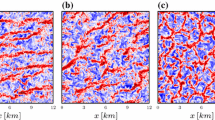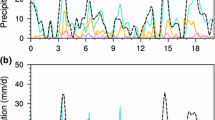Abstract
The boundary-layer development and convection-pattern transition typically occurring in cold-air outbreaks is studied using three-dimensional simulations. The simulations include the secondary-flow transition starting with the relatively small-scale boundary-layer rolls developing during the initial phase and ending with mesoscale cellular convection patterns. The application of a computational grid, whose horizontal mesh size enables the resolution of the small-scale initial patterns and whose domain size is large enough to capture mesoscale convection patterns, overcharges even state-of-the-art supercomputers. In order to bypass the computer storage problem, the horizontal size of the model domain and the horizontal resolution of the computational grid are adjusted to the scale of the dominant convective structures. This enables the simulation of convection cells whose horizontal scales increase up to values exceeding the size of the initial model domain.
The model is applied to conditions of a cold-air outbreak observed during the ARKTIS 1991 experiment. The most important characteristics of the observed situation are revealed by the model. Sensitivity studies are performed in order to investigate the relation between cell broadening and various physical processes. The artificial cutoff of liquid-water formation prevents the enlargement of convective scales. Latent heating due to condensation and especially radiative cloud-top cooling are identified as processes leading to cell broadening. We propose a conceptual model that elucidates the mechanism by which cloud-top cooling may generate larger aspect ratios.
Similar content being viewed by others
References
Agee, E. M., Chen, T. S. and Dowell, K. E.: 1973, ‘A Review of Mesoscale Cellular Convection’,Bull. Amer. Meteorol. Soc. 54, 1004–1012.
Agee, E. M.: 1984, ‘Observations from Space and Thermal Convection: A Historical Perspective’,Bull. Amer. Meteorol Soc. 65, 938–949.
Bénard, H.: 1901, ‘Les Tourbillions Cellulaires dans une Nappe Liquide Transportant de la Chaleur par Convection en Regime Permanent’,Ann. Chim. Phys. 23, 62–144.
Brown, R. A.: 1980, ‘Longitudinal Instabilities and Secondary Flows in the Planetary Boundary Layer: A Review’,Rev. Geophys. Space Phys. 18, 683–697.
Brugge, R. and Moncrieff, M. W.: 1985, ‘The Effect of Physical Processes on Numerical Simulations of Two-Dimensional Cellular Convection’,Contr. Atmos. Phys. 58, 417–440.
Brümmer, B. (ed.): 1992, ‘ARKTIS 1991 — Report on the Field Phase with Examples of Measurements’,Berichte aus dem Zentrum für Meeres- u. Klimaforschung, Reihe A, 3, 216 Seiten.
Chlond, A.: 1988, ‘Numerical and Analytical Studies of Diabatic Heating Effect Upon Flatness of Boundary Layer Rolls’,Contr. Atmos. Phys. 61, 312–329.
Chlond, A.: 1992, ‘Three-Dimensional Simulation of Cloud Street Development During a Cold Air Outbreak’,Boundary-Layer Meteorol. 58, 161–200.
Clark, T., Hauf, T. and Küttner, J. P.: 1986, ‘Convectively Forced Internal Gravity Waves: Results from Two-Dimensional Numerical Experiments’,Quart. J. Roy. Meteorol. Soc. 112, 899–925.
Deardorff, J. W.: 1980a, ‘Stratocumulus-Capped Mixed Layers Derived from a Three-Dimensional Model’,Boundary-Layer Meteorol. 18, 495–527.
Deardorff, J. W.: 1980b, ‘Cloud Top Entrainment Instability’,J. Atmos. Sci. 37, 131–146.
Fiedler, B. H. and Peckham, S.: 1992, ‘Numerical Study of Convective Scale Selection in a Cloud-Topped Marine Boundary Layer’,Tellus 44, 366–380.
Fiedler, B. H.: 1993, ‘Cell Broadening in Three-Dimensional Thermal Convection Between Poorly Conducting Boundaries’,Beitr. Phys. Atmosph. 66(3), 173–181.
Hardy, K. R. and Ottersten, H.: 1969, ‘Radar Investigations of Convective Patterns in the Clear Atmosphere’,J. Atmos. Sci. 26, 666–672.
Hsu, W.-R., Sun, W.-Y.: 1991, ‘Numerical Study of Mesoscale Cellular Convection’,Boundary-Layer Meteorol. 57, 167–186.
Kessler, E.: 1969, ‘On the Distribution and Continuity of Water Substance in Atmospheric Circulation’, Met. Monograph. 10, 32, American Meteorol. Soc., Boston, pp. 1–84.
Küttner, J. P.: 1971, ‘Cloud Bands in the Atmosphere’,Tellus 23, 404–425.
Lenschow, D. H. and Agee, E. M.: 1976, ‘Preliminary Results from the Air Mass Transformation Experiment (AMTEX)’,Bull. Amer. Meteorol. Soc. 57, 1346–1355.
Lewellen, W. S.: 1977, ‘Use of Invariant Modeling’,Handbook of Turbulence, Plenum, 237–290.
Lilly, D. K.: 1968, ‘Models of Cloud-Topped Mixed Layers under a Strong Inversion’,Quart. J. Roy. Meteorol. Soc. 94, 292–309.
Melfi, S. H., Spinshirne, J. D., Chou, S.-H. and Palm, S. P.: 1985, ‘Lidar Observations of Vertically Organized Convection in the Planetary Boundary Layer over the Ocean’,J. Climate Appl. Meteorol. 24, 806–821.
Mellor, G. L. and Yamada, T.: 1974, ‘A Hierachy of Turbulence Closure Models for Planetary Boundary Layers’,J. Atmos. Sci. 31, 1791–1806.
Moeng, C.-H. and Schumann, U.: 1991, ‘Composite Structure of Plumes in Stratus-Topped Boundary Layers’,J. Atmos. Sci. 48, 2280–2291.
Müller, G.: 1995, ‘Mesoskalige Zellularkonvektion in Abhängigkeit von unterschiedlichen physikalischen Prozessen und synoptischen Randbedingungen - Numerische Simulationen’,Berichte aus dem Zentrum für Meeres- u. Klimaforschung, Reihe A16, 144 pp.
Raasch, S.: 1990, ‘Numerical Simulation of the Development of the Convective Boundary Layer During a Cold Air Outbreak’,Boundary-Layer Meteorol. 52, 349–357.
Rayleigh, D.: 1916, ‘On Convection Currents in a Horizontal Layer of Fluid, When the Higher Temperature is on the Under Side’,Phil. Mag. Ser. 6(32), 529–546.
Rothermel, J. and Agee, E. M.: 1986, ‘A Numerical Study of Atmospheric Convective Scaling’,J. Atmos. Sci. 43, 1185–1197.
Sasaki, Y.: 1970, ‘Influences of Thermal Boundary Layer on Atmospheric Cellular Convection’,J. Meteorol. Soc. Japan 48, 492–502.
Sheu, P.-J., Agee, E. M. and Tribbia, J. J.: 1980, ‘A Numerical Study of Physical Processes Affecting Convective Cellular Geometry’,J. Meteorol. Soc. Japan 58, 489–498.
Sommeria, G. and Deardorff, J. W.: 1977, ‘Subgrid-Scale Condensation in Mmodels of Nonprecipitating Clouds’,J. Atmos. Sci. 34, 344–355.
Sündermann, A.: 1990, ‘Die Anwendung von adaptiven Gittern in zwei einfachen Modellen für eine atmosphärische Rollenzirkulation’,Berichte aus dem Zentrum für Meeres- u. Klimaforschung, Nr. 5.
Sykes, R. I., Lewellen, W. S. and Henn, D. S.: 1988, ‘A Numerical Study of the Development of Cloud Street Spacing’,J. Atmos. Sci. 45, 2556–2569.
Sykes, R. I., Lewellen, W. S. and Henn, D. S.: 1990, ‘Numerical Simulation of the Boundary-Layer Eddy Structure During the Cold-Air Outbreak of GALE IOP2’,Mon. Wea. Rev. 118, 363–374.
Author information
Authors and Affiliations
Rights and permissions
About this article
Cite this article
Müller, G., Chlond, A. Three-dimensional numerical study of cell broadening during cold-air outbreaks. Boundary-Layer Meteorol 81, 289–323 (1996). https://doi.org/10.1007/BF02430333
Issue Date:
DOI: https://doi.org/10.1007/BF02430333




